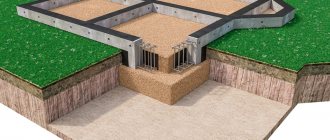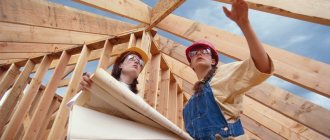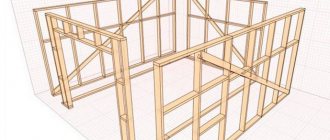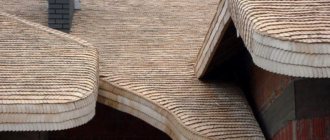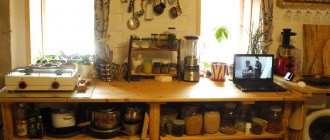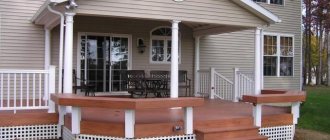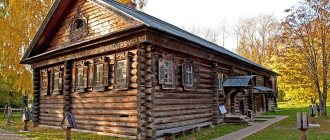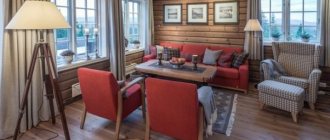Building a private house with your own hands is a difficult task. No, building a good house that will last for many decades is a really difficult task. Especially if you pay attention to the number of little things that need to be taken into account at all stages of preparation and construction itself. It seems like it can't be dealt with. However, today we have prepared for you about 100 useful and practical tips that will help you design a project, draw up an estimate and, ultimately, build a reliable and good house from scratch.
Build a private house with your own hands
In the article, we tried to take into account even such little things as the basic convenience of window placement or the correct height of steps on the stairs. Advice is given by the most experienced developers of our time. Plus, don’t forget about the mistakes of others, which we will also look at in the article. To build a private house with your own hands you need not only money, but also a competent approach. Below are all the main stages of building a private house.
Nuances of choosing technologies and materials
At the design stage, a technology and wall material are selected that will meet the construction budget and the do-it-yourself execution mode. When choosing materials, they are guided by their specific properties and the pace of construction - if frames or wooden log houses are assembled in winter, then laying bricks or various blocks should be delayed until the warm season. When construction is planned in stages over several years, it is important to select a technology in which the box will overwinter without a roof, without losses, and will stand quietly for several more years without heating.
If you intend to purchase and long-term storage of building materials in order to save money, you should pay increased attention to storage conditions and shelf life. After its expiration, building mixtures lose a significant part of their properties, even if they do not petrify due to high humidity. Usually the terms and conditions are specified in the instructions, which they mistakenly do not consider necessary to comply with, and then they blame them for poor quality, although the mirror shows the culprits. Plus, you shouldn’t be fooled by suspiciously low selling prices, as in everything, miracles are rare in construction and good quality almost never goes in tandem with cheapness.
Today, the private sector is represented by several popular types of houses.
Frame - predominantly a wooden frame made of dry boards, less often of metal (LSTC), very rarely of timber (Fachwerk, Timberframe) or logs (Post and Beam), filled with insulation and lined inside and out. They are characterized by high speed of construction and relative ease of assembly, which does not require professional skills. They are mistakenly considered budget, but if the technology is followed and high-quality materials are used (dry boards, sufficient thickness of insulation, vapor barrier, wind protection), the finished square is no cheaper than in any other house. Another myth is that frame buildings are non-permanent temporary buildings. Yes, frame houses lack solidity and heat capacity, but this problem is solved by installing a slab foundation and high-quality calculation of the load-bearing post-beam frame. However, if you plan to build a house for seasonal stays and weekend visits in winter, an insulated slab or floors on the ground are not the best option when you need to quickly heat a house that has dried out in a week. A proper frame made of high-quality wood will last for decades without any complaints, and it’s realistic to celebrate a housewarming party in just a couple of months, even if it’s a self-built or mono-building project.
Wooden ones - they practically no longer build from “shaggy” raw timber; wooden houses should be understood as log houses made of logs (rounded, hand-cut), profiled and laminated timber. Wooden houses are valued for their originality and special microclimate, and one of the main advantages is their simplified finishing; the walls do not need to be plastered or covered. But wood also has significant disadvantages - a log frame will shrink for several years, a glued one practically does not shrink, but it is better to look into compensators. And wooden houses require increased attention and regularly, they need to be sanded, the log houses also need to be caulked (warm seam), and coated with specialized products. You can slightly increase the interval between treatments with protective and decorative compounds when using expensive but high-quality products from famous brands.
Dmitri1971FORUMHOUSE Member
On my own behalf, I will say that over the years our requirements for the quality of finishing have become so laminated that before building a wooden house, think a hundred times whether you are ready to put up with unevenness, different colors, roughness, splinters and abundant care for natural material. I sand wood - the workers just run away when you start demanding quality.
Stone - this concept now unites houses made of materials such as brick, warm ceramics and various concrete-based blocks. For a large number of self-builders, there is no alternative to stone houses, they only perceive them as capital ones, but here everything is subjective. Entirely brick houses are becoming increasingly rare, since this material is characterized by a high thermal conductivity coefficient, and not everyone is ready to make a wall with a thickness of 60 cm or more. More often, the box is laid out from large-format warm ceramics or aerated concrete (foam concrete, slag concrete, etc.), and the lining is made of brick. If bricklaying requires a certain level of skill, then working with large format is both easier and faster. Stone houses, even when it comes to lightweight blocks, need a reliable foundation - a slab, strip or piles with a grillage. Due to wet processes, the box is erected only at positive temperatures.
Reinforced concrete is also a technology that is demanding for the construction season; a cement-based mortar with various aggregates is poured into removable or permanent formwork with an installed reinforcement cage. In the first case, after the construction of the box, additional insulation will be required, in the second, only finishing of the facade. Monolithic houses are as strong, reliable and durable as possible; with good quality concreting (smooth formwork, no leaks or expansion to the sides, self-compacting concrete or vibration), the walls are ready for finishing and do not require leveling. The main disadvantage is the very high labor intensity, which is especially significant in the case of a mono-building.
In the general construction budget, the share of the box with roof and glazing accounts for 30 to 40%, and the rest goes to communications, interior and exterior decoration. When it comes down to it, you can live in a box with bare walls and plumbing, gradually finishing off room by room. But you need to think about this course of events at the planning stage, choosing the appropriate design and material.
Necessary communications
Necessary communications include: water supply, heating, electricity. You can use a gas boiler to heat your house. Thanks to it, in winter you can significantly reduce the cost of heating your home.
If funds allow, you can make a heated floor right away during construction (we all know that heat goes from bottom to top) - install plastic pipes into the floor, and fill it with concrete screed on top. This way you can heat the whole house. An alternative to such a warm floor can be solar energy, which will not allow you to freeze even on cold winter evenings.
The sewer system must be laid before finishing and pouring the floor. It is also necessary to lay a water supply system before completing this work. It is necessary to designate in advance where the rooms and household appliances that require drainage will be located. All pipes must be laid according to the stated diagrams.
If you do not have access to a central system, you can dig a well or borehole. Unfortunately, these are not very cheap options.
Rules for construction on land plots
As mentioned above, there are construction norms and rules that must be followed.
They touch:
- purpose of land (land can be intended for individual construction, or maybe only for garden houses);
- size and area of the site;
- sanitary standards;
- fire safety;
- distances between buildings.
It is also important to take into account the norms for the indentation of objects from the border:
- with neighbors;
- tree planting standards;
- construction of additional facilities, such as a bathhouse and a garage.
The rules for installing a fence on a plot of land are also important.
Legislative regulation
To start building a house on a plot of land, it is recommended to look at the following documents :
SNiP 30-02-97.
This code regulates the planning and development of the territories of gardening associations of citizens, buildings and structures. The regulation states how to determine the location of objects on a site relative to its boundaries.- SNiP 2.07.01-89. It tells about the planning and development of urban and rural settlements. The act defines the rules for laying pipelines and water supply between different sections.
- SNiP 2.04.01-85. He will tell you about the standards for laying internal water supply and sewerage systems.
- SNiP 2.04.08-87. Will tell you about gas supply standards at the site.
All these sets of rules will help you understand housing construction legislation at its initial stage.
Learn more about the standards and rules for building a house on a self-storage basis here.
Why is the project needed?
Because construction according to a competent project means reducing costs, reducing deadlines, and minimizing force majeure. Ideally, you need to build according to an individual project, developed to suit your needs and capabilities, which will take into account the “wants” of all family members. But its cost is higher than the standard one, which for many becomes the main disadvantage and an argument in favor of standardization. Axiom - even a standard project is better than none. You can prove the opposite with foam at the mouth, referring to the centuries-old experience of fathers and grandfathers, but in practice, today utility blocks and toilets are built with at least a drawing, or a permanent house. Visualization of facades and a set of layouts are not a project; rather, they are a visual aid that helps make a choice. A full-fledged project, on the basis of which you can build a private house with your own hands, includes several sections.
- The architectural section (AR) is precisely its part that people are trying to sell at a bargain price instead of a package of working design documentation. AR includes data on facades (sections, finishing), planning solutions, specifications of windows and doors.
- Structural section (SC) - includes several subsections and reflects the most important information on load-bearing structures. If AR is more likely to be pictures tied to dimensions, then in KR architectural solutions are translated into plans and drawings of the foundation, walls, ceilings, and rafter system. It contains all the calculations and characteristics of the critical components, detailed statements, and also shows the order of work.
- Engineering section - calculations and drawings of life support systems (electricity, water supply, sewerage, ventilation, heating).
You can purchase ready-made standard house designs from almost any specialized company and the amounts are quite feasible, but they have no goal of reducing the construction budget. To prevent construction from turning into a long-term construction, or even unfinished, when choosing (developing, ordering) a project, you need to consider the following.
- The simpler, the cheaper - this instruction sounds from every iron, but this does not lose its relevance. A well-thought-out, many-times-tested layout that is in no way tied to the shape of the house will be convenient. And bay windows, ledges, arches and similar graces only increase the cost and complexity of construction. Instead of an extra room designed for guests who do not come every year, it is more useful to provide a technical room for a laundry room or dressing room with storage systems.
- When a second floor is justified - when the plot is small and a one-story house of the required area does not fit, especially taking into account the current regulatory distances. Another argument in favor of a second or attic floor can be the beautiful view that will open from the windows. In financial terms, the savings due to the smaller foundation perimeter and roof area will be “eaten up” by the stairs and the increased labor intensity of the work.
axel1981FORUMHOUSE Member
A two-story house 6x8 m: its total area (not counting the walls) is 96 m², we subtract 16 m², because they will be needed for the stairs, we have up to 80 m², comparable to a one-story building, 10x8 = 80 m². Let’s calculate the foundation of a one-story building along the perimeter (we don’t want to count everything), in total, 36 linear meters, for a two-story building – 28 linear meters, a difference of 28%. The roof area, also conditionally, is 80 squares versus 48, 40% more, then it will be more interesting: we calculate the area of the walls with a ceiling height of 2.5 meters, one floor - 90 m², two floors - 140 m². The walls of a two-story house are 36% larger, and this is also an important component of costs. Let's calculate the volume of heated air: one floor - 200 m³, two floors - 240 m³, it is more expensive to heat. A good staircase costs good money, in old age it is difficult to walk on it, high-rise work is more expensive, and in the case of unauthorized construction, or even more so a mono-building, it is difficult to complete.
- Type of foundation - the more massive the private house and the more demanding the wall material is for the foundation, the more you will have to invest in the foundation.
- The shape of the roof - hip ones attract attention, but are also more expensive, due to the materials and work involved, roof windows also increase the budget. Gable roofs are simpler to make, more reliable and cheaper; presentation can be added due to the type of roofing or different chalet-style slopes.
- Windows - any non-standard increases the price tag on window units by an order of magnitude, panoramic ones also “bite”, when the budget is not in last place, it is worth making do with standard rectangular structures. But you shouldn’t skimp on quality and energy-saving parameters, especially when in the region where you live you won’t get the sun in the summer, but frosts and winds are frequent guests.
- Facade - today there is a huge selection of finishing materials and entire systems, both with and without insulation, it is possible to choose both a budget and a presentable option.
- The interior is trending minimalism, which goes well with self-construction, and if you are planning a house made of timber with your own hands, then the question of interior decoration disappears as such. Even in damp rooms, tiles and other insulating coatings can be replaced with a high-quality decorative and protective composition based on oil and wax. When finances allow, they spend almost more on interior decoration than on a warm perimeter (a box under a roof with windows and a door). But if your budget is modest, it’s quite possible to get by with high-quality painted walls and create a stylish look by adding accents with color and textiles.
- Built-in premises - if an additional dressing room, boiler room or pantry is functional, then a built-in garage or sauna is a complication and increase in cost of the project.
YuryFORUMHOUSE Member
The simpler the house is in plan, the more economical it is to build, the more reliable it is and will have less heat loss. Plans with either one long internal load-bearing wall or two short ones give good results.
There are many examples when people plan to build a house with their own hands not because of a desire to cut costs, but because of the conviction that this is the only way to really achieve reliability and durability. In these cases, you can afford complex shapes with a sloping roof, panoramic glazing, including doors, not just windows, and finishing with natural wood and marble. But when there is frankly little money, you need to realistically assess your strengths and select a project that is simple in all respects. It’s better to live in a “transformer booth” than to build a palace for “twelve” years and then unsuccessfully try to sell the unfinished building.
Storage layout
There are a number of rules and nuances when planning a construction site:
- To begin with, they determine the nature of the soil of the earth. If the groundwater level is high, then drainage work must be carried out. If the aquifer is deep, the location for drilling the well is determined.
- Mutual arrangement of buildings. Often, when planning, they include such capital construction projects as a residential building, outbuildings, a recreation area, a garage, a sauna, a children's playground, and a garden area. All this must be arranged organically and maintaining the permissible distance between them.
The location for the house is chosen depending on the terrain. If there is a hill on an empty plot, then it is better to place the house there. There are central, deep and front landings of the house. Outbuildings are located away from the house. The garage is located as close to the exit as possible.
Planning rules for different plot sizes are in the section at the link.
Video description
The video will tell you more about determining the required area of the house and its layout:
See also: Catalog of companies that specialize in the construction of frame houses
We get a box of 12x15 meters. In the case of a small area, you can think about reducing the parameters by using a second floor or attic. We transfer these dimensions to scale onto graph paper, a sheet of squared paper, or into a computer program. The last option is the most convenient, as it allows you not only to make changes, but also to view the project in a three-dimensional image. And also immediately think about the placement of equipment, furniture and household appliances.
Screenshot from the Sweet Home 3D program page Source i.ibb.co
Stage two - sketches
At the second step, all conditions and desires are taken into account and assembled into a certain model of a house with a certain number of floors and rooms.
We recommend: How to extend the life of seals in plastic windows?
The preliminary design has the character of a sketch and depicts the future of the building from different sides: facade, side, rear and section (transverse and longitudinal).
It also provides a list of materials used, as well as the design features of the house: type of roof, thickness of walls and ceilings.
Before you begin your own home project, it is better to carefully study photos of finished plans to gain ideas and experience.
